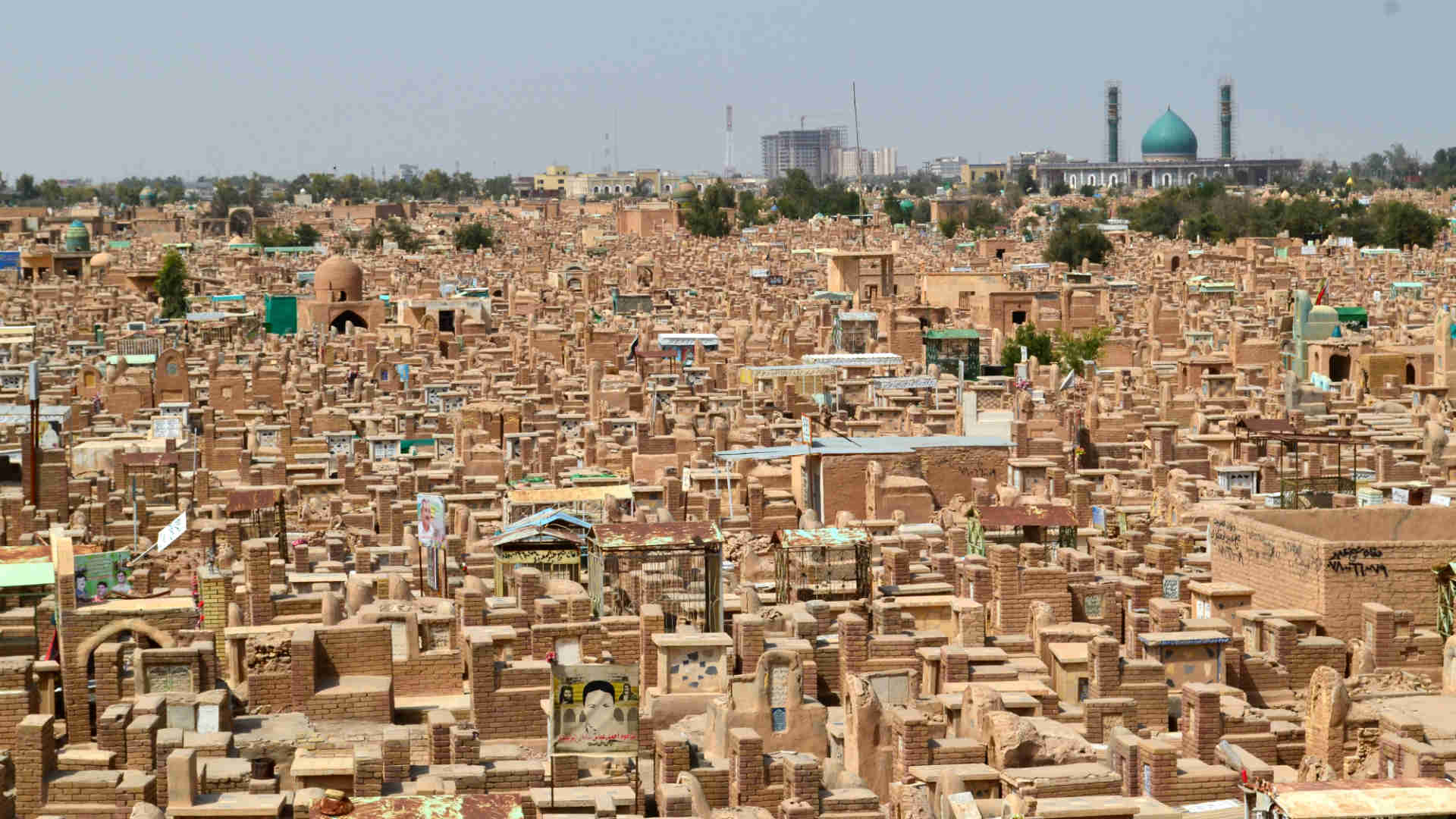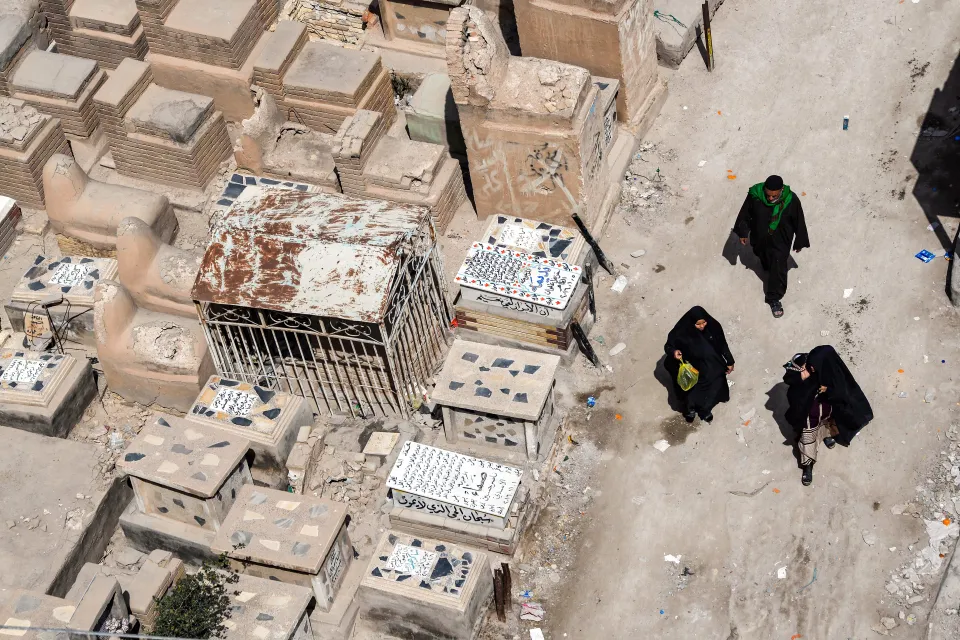Wadi Al-Salam Cemetery (Arabic: وادي السلام), located in the city of Najaf, Iraq, is considered the largest cemetery in the world and is a sacred Islamic burial site. Meaning "Valley of Peace," this cemetery holds spiritual significance for millions, particularly Shiite Muslims. Covering an area of approximately 1,500 acres (around 6 km²), the cemetery makes up 13% of Najaf's total surface area and is home to more than 6 million graves. Today, it is reported that around 50,000 people are buried there annually. The cemetery's history dates back to periods before the 13th century and it continues to expand.
History
The history of Wadi Al-Salam Cemetery stretches back to ancient times. The cemetery contains the graves of kings, sultans, and leaders from ancient civilizations, such as Iraq’s Al-Hira Kingdom. The cemetery was used even during the pre-Islamic period, making it significant both historically and religiously. Its sacredness has been reinforced particularly by its proximity to the shrine of Ali ibn Abi Talib, the first Shiite imam. The presence of Imam Ali in Najaf has turned this place into both a religious center and an important burial destination.
Over time, this sacred site has become a place where not only the local population but Muslims from all over the world wish to be buried. The expansion of the cemetery over the years is especially linked to rising burial rates during wartime and periods of political turmoil.
In an application to UNESCO, the cemetery’s area was specified as approximately 917 hectares, which is equivalent to 1,700 football fields. Before the area became home to so many graves and shrines as it is today, it was known as a site of ancient burial grounds.

Wadi Al-Salam Cemetery. [Gareth Browne]
Physical Features of the Cemetery
When viewed from satellite images, Wadi Al-Salam resembles the silhouette of a city; the gravestones and shrines appear like small buildings. The cemetery is notable for its density; many graves are lined up extremely close to each other. This situation has created both a demand for new burial space and spatial limitations.
Rooms and chambers built underground have allowed the cemetery to expand vertically as well. Some underground graves are designed to hold up to 50 bodies. This practice shows that the cemetery has a complex burial network not only on the surface but also underground. In Wadi Al-Salam Cemetery, gravestones are usually made of baked bricks and plaster. These gravestones are constructed in accordance with traditional Islamic burial practices. The structural characteristics of the cemetery reflect the burial traditions of the region. The use of underground layers and underground burial chambers allows for the burial of multiple bodies at once, which is especially necessary when large numbers of funerals need to be conducted simultaneously. Many families purchase special underground rooms for their family burial plots.
Religious Importance and Visitor Flow
Wadi Al-Salam Cemetery holds great religious significance, particularly for Shiite Muslims. Due to its proximity to the shrine of Imam Ali ibn Abi Talib, the cemetery is considered extremely sacred in Shiite beliefs.
Every year, thousands of Muslims visit the cemetery to pay respects to the graves of leading religious figures, kings, sultans, and scholars buried there. The cemetery is regarded as one of the most important and sacred pilgrimage sites of Shiite beliefs.

Wadi Al-Salam visitors. (Source: AFP)
Daily Burial Rates and the Effect of War
Political instability and years of conflict in Iraq have significantly increased the burial density at Wadi Al-Salam. The Iran-Iraq War, the post-2003 American invasion, and the 2004 clashes between the Mahdi Army and American forces dramatically raised the daily burial rates at the cemetery. During the most intense periods of war, between 250 and 350 funerals were held there each day. Some sections of the cemetery directly turned into battlefields; shrines, gravestones, and structures were damaged by gunfire, rockets, and explosions. During this period, the cemetery became not only a burial site but also a strategic refuge for insurgents and militants. According to a 2021 Reuters report, Wadi Al-Salam has been expanding at nearly twice its normal growth rate.
Religious and Cultural Importance
Due to its proximity to the Imam Ali Shrine, Wadi Al-Salam is especially consecrated as an eternal resting place for Shiite Muslims. The bodies of those who wish to be buried in the cemetery are first taken to the Imam Ali Shrine to be circumambulated for blessing and then transported to the cemetery for burial. This religious ritual further enhances the cemetery's spiritual status.
Social Structure and Cemetery Economy
The cemetery functions not only as a religious site but also as an economic and social center. Burial procedures and the production of gravestones are important sources of income for the local population. Groups working in the cemetery, especially grave diggers, sustain their daily lives through jobs in this area. Some groups have organized the burial procedures and established their own offices, offering services such as transporting bodies, managing burial expenses, and engraving gravestones. The sale of private underground burial chambers for family plots is also common. Some families prefer to buy these underground burial rooms collectively as family graveyards. Even the cheapest burial plots are valued at approximately 240 British pounds. The scarcity of burial space has led to issues such as grave theft and the reuse of old graves.
Symbolic Figures and Historical Personalities
Wadi Al-Salam is the eternal resting place not only for ordinary people but also for historically significant figures. The cemetery reportedly houses:
- Prophets,
- Sultans,
- Royal family members,
- Members of dynasties such as the Fatimids, Buyids, Safavids, Qajars, and Jalayirids,
- Scholars
The presence of these figures shows that Wadi Al-Salam is a silent witness to history.
Spiritual Narratives and Folk Beliefs
According to the accounts of grave diggers, some have reported encountering mysterious events and ghosts in the cemetery; these stories have even caused some workers to quit their jobs. Such folk narratives suggest that the cemetery is imagined not only as a physical space but also as a metaphysical one.


